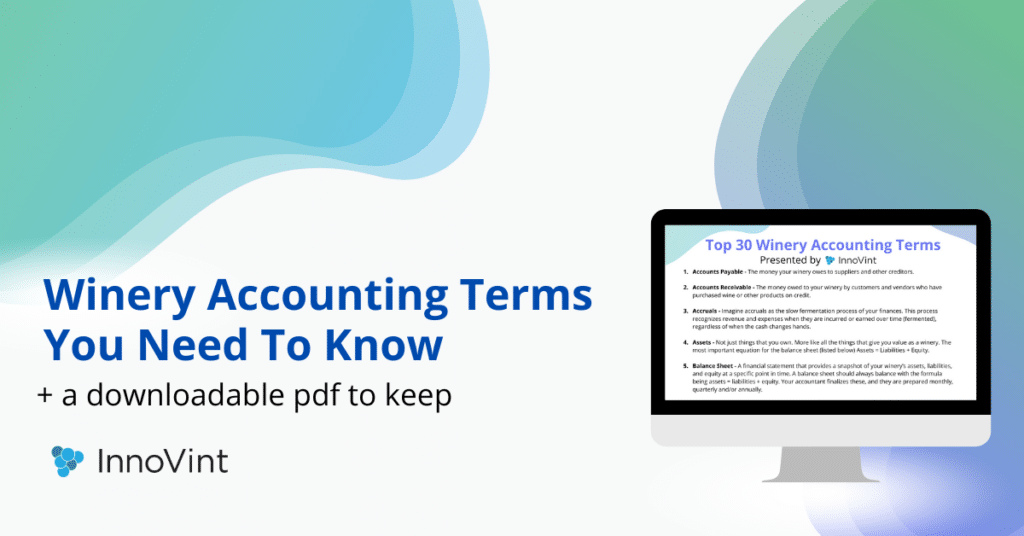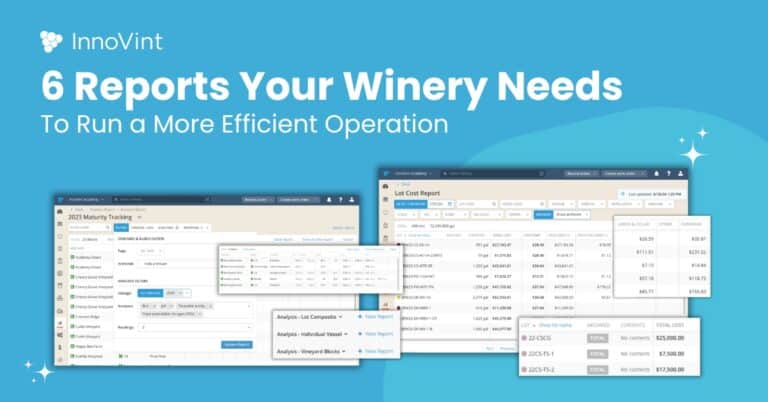We’ve all been there, lost in a conversation about COGS and EBITDA and hoping no one asks you to explain what they mean let alone what the acronym stands for. Being well-versed financially is an important skill set for winemakers and business owners to make informed decisions and manage their businesses more effectively.
Check out the top 30 finance terms below or download this handy PDF to keep by your desk.
- Accounts Payable – The money your winery owes to suppliers and other creditors.
- Accounts Receivable – The money owed to your winery by customers and vendors who have purchased wine or other products on credit.
- Accruals – Imagine accruals as the slow fermentation process of your finances. This process recognizes revenue and expenses when they are incurred or earned over time (fermented), regardless of when the cash changes hands. (I hope that made it better, not worse)
- Assets – Not just things that you own. More like all the things that give you value as a winery. Your equipment, your vineyards, trucks, wine in bond, you get the picture. The most important equation for the balance sheet (listed below) Assets = Liabilities + Equity.
- Balance Sheet – A financial statement that provides a snapshot of your winery’s assets, liabilities, and equity at a specific point in time. A balance sheet should always balance with the formula being Assets = Liabilities + Equity. Your accountant finalizes these, and they are prepared monthly, quarterly and/or annually.
- Break-Even Point – The point in time where your sales coming in equals your expenses going out. This is when a winery is no longer operating at a loss and will now start turning a profit. As a growing winery, it’s important to forecast when you anticipate this to be.
- Budgeting – An important activity that requires you to estimate your future expenses. This is an important activity for any business to make strategic investment decisions that align with your financial expectations and keep the winery in good health.
- Capital – The financial fuel that propels your winery forward. Think of it as the vineyard’s lifeblood, essential for planting the seeds of success. Whether it’s sourced from investors or loans, smartly managing your capital is like cultivating a healthy vineyard – it leads to richer, more robust wines.
- Capital Expenditure – Investments in long-term assets, such as equipment or vineyard expansion, that typically have a lifetime value over one year.
- Cash – The liquid asset that keeps your winery flowing smoothly. It’s the crisp bills and jingling coins that ensure your operations are as refreshing as a chilled glass of Reisling. Just like a well-stocked cellar, having enough cash on hand ensures your winery can weather any unexpected storms.
- Cash Flow – The movement of money in and out of your winery, indicating liquidity. Think of this as the cash moving through the sale of wine, and the money going out when you pay for barrels, bottles, grapes, etc. This breaks down to (Operating Cash Flow = Operating Income + Non-cash Expenses – Taxes + Changes in Working Capital). The goal here is for this number to be positive, in case that wasn’t clear.
- COGS – What the heck is COGS (cost of goods sold)? What a funny term. COGS is the absolute, final, end-of-the-manufacturing-process value of a wine when it’s finally packaged. Before that, it’s work-in-progress costs or bulk inventory costs that sit as an asset on the balance sheet (because it’s not done yet, not ready to sell). COGS is calculated based on all the costs that went into producing it, from grapes to packaging materials to your winemaker’s salary and more. This is a critical metric to compare against your revenues and know your profitability.
- Cost Allocation – The assignment of costs to specific inventory units or activities. Just like a winemaker allocates specific barrels to different wine lots, certain costs must be allocated to inventory as they’re incurred.
- Credit Terms – The agreed-upon terms with suppliers or customers regarding payment and credit periods
- Depreciation – The gradual decrease in the value of your winery’s assets over time. Think of your press losing value year after year as you use it, your barrels decreasing in value each time you empty and refill them, or how your tractors lose value as they require more maintenance year over year. Depreciated asset value is an important practice to do correctly for winery financials.
- Dividends – The sweet rewards sometimes shared with stakeholders when a winery turns a profit. Imagine it as the ultimate toast – a celebration where everyone gets a sip of success.
- EBITDA – It stands for Earnings Before Interest, Taxes, Depreciation, and Amortization. That’s a lot of big words, but it basically means what your net income is after all revenue streams and expenditures are recognized. It provides a clear picture of whether you’re making money or losing money and can be a useful metric for evaluating performance, comparing against industry benchmarks, and making strategic decisions.
- Equity – The ownership interest in your winery, representing the residual interest after deducting liabilities from assets.
- Expenses – The costs associated with running the winery, including production, marketing, and administrative expenses.
- GAAP (Generally Accepted Accounting Principles) – The tried and true recipe for financial reporting. Think of it as the winemaking formula for your finances, providing a standardized method that ensures everyone’s speaking the same financial language. Following GAAP is like using a pre-programmed press cycle, consistency is key for reproducibility and accuracy.
- Gross Profit – This is your revenue minus the cost of goods sold (COGS), which represents the basic profitability of your winery. This breaks out to (Revenue – COGS = Gross Profit). So if you’re selling your wine at $100/bottle, and your COGS is $75/bottle – your gross profit is $25. Super easy to calculate in our COGS module 😉
- Gross Margin – Gross Margin is a valuable figure to understand how production costs relate to revenue. It is calculated by subtracting the costs to produce a wine from the revenue generated by selling it. Say your winery sells a bottle of wine for $32, and the cost to produce that bottle is $15/bottle, therefore your Gross Profit is $17 per bottle, and your Gross Margin is 53%.
- Income Statement – Also often known as a Profit & Loss (P&L) Statement, this is a financial report that shows your winery’s revenue, expenses, and profit or loss over a specific period. Your accountant finalizes these, and they are prepared monthly, quarterly and/or annually.
- Liquidity – Liquidity is how quickly you can get your hands on your cash. This is the ability to convert an asset into cash, and the easier it is, the more liquid that asset is. Finished wine and ripe grapes are some of the most liquid assets a winery can have.
- Liabilities – Represent the financial obligations and debts that a winery owes to external parties. These obligations can include loans, accounts payable, and other debts that need to be settled over time.
- Net Profit – The amount of money you made after deducting all your expenses from what you earned.
- Profit Margin – The percentage difference between revenue and expenses, indicating the profitability of your winery. You calculate this easily as Profit Margin = (Net Income/Revenue) x 100. Maximizing profitability is to every winery’s advantage.
- Revenue – The total amount generated from wine sales, events, and any other source of income.
- ROI (return on Investment) – A term used to evaluate how well an investment or purchase performed for the business. For example, a return on investment may be very quantifiable, like a paid advertisement that gained the business more sales than it cost, or it might be more subjective, like the amount of time saved per week to focus on more important work because new efficiencies were put into place.
- Working Capital – The money you have to invest in day-to-day operations to run the business. This is an important indicator of whether a company’s cash flow is healthy enough to continue to fuel growth with proactive spend.
Feel smarter? Good. Here’s an easy download you can keep on your desk to reference when these come up again and you need a little refresher.
Looking to further master your winery’s finances?
Did we leave any terms out? Is there another example you would like to share? Chime in on The Punchdown where other like-minded winery professionals go to connect and communicate with one another.
Familiarize yourself with the top mistakes wineries make when managing their finances or watch the on-demand video of the discussion.
You can also check out Protea Academy on YouTube, a weekly discussion on accounting for vineyards. Zane Stevens, a founding partner of Protea Financial and a leader in the winery accounting field, was an editor of this article. Here’s one of their episodes featuring our CEO, Ashley Leonard, talking about inventory management and cost accounting for wineries.



